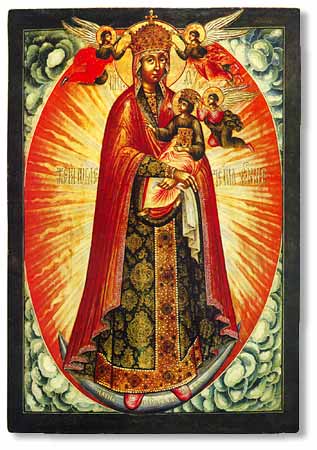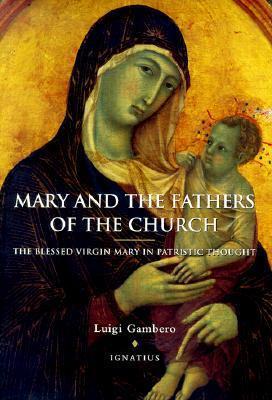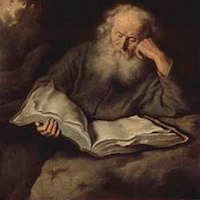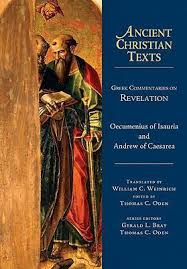MARIAN INTERPRETATION OF THE WOMAN CLOTHED WITH THE SUN ACCORDING TO THE FATHERS OF THE CHURCH

The identification of Mary as the “woman clothed with the sun” in Revelation 12 finds support in the Fathers of the Church. The first extant patristic source on the Marian identification of the woman of Revelation 12 is St. Epiphanius of Salamis (d. 403). He wrote:
“But elsewhere, in the Apocalypse of John, we read that the dragon hurled himself at the woman who had given birth to a male child; but the wings of an eagle were given to the woman, and she flew into the desert, where the dragon could not reach her” (Rev. 12:13-14). This could have happened in Mary’s case.”[1]
Steve Puluka, a liturgy, church history and patristics teacher at Manor College[2] comments that –
“This passage merely mentions the association exists without really endorsing the view wholeheartedly himself. He qualifies the identification with [Mary] dare not affirm this with absolute certainty. But this silence of the early evidence is as much a reflection of the dearth of material interpreting Revelation at all from the time period. The references to any aspect of the book are few and far between in the extant literature. But the tepid mention by Epiphanius demonstrates that the existence of a Marian identification of the woman in the same time period was widespread enough that he could not pass the text without comment on it.” (underscoring supplied)

Mariologist Michael O’Carroll notes that “[t]here is in the same age a vague reference in Andrew of Caesarea to people who identified the woman with Mary.”[3] Both Epiphanius of Salamis and Andrew of Caesaria[4] both record that some ‘some people’ identified the woman clothed with the sun as Mary the mother of Jesus; but they do not say who those people were.[5] Hence, it can be said that the opinion was known in the fourth century.[6]
In 430 A.D., Quodvultdeus,[7] a disciple and friend of St. Augustine of Hippo, made the first overtly Marian identification of the woman of Revelation 12: “None of you is ignorant of the fact that the dragon was the devil. The woman signified the Virgin Mary.” [8]
According to Quodvultdeus, fifth century Father of the Church and Bishop of Carthage:
“The Woman signifies Mary, who, being spotless, brought forth our spotless Head. Who herself also showed forth in herself a figure of holy Church, so that as she in bringing forth a Son remained a Virgin, so the Church also should during the whole time be bringing forth His members, and yet not lose her virgin state.”[9]
Since Quodvultdeus was a disciple and close friend of St. Augustine of Hippo, Le Frois argues that “Augustine also must have had Mary in mind in his sermon on Ps. 142,[10] especially as his disciple and close friend, Quodvultdeus, expressly makes the identification: ‘mulierem illam virginem Mariam significasse, quae caput nostrum integra integrum peperit, quae etiam ipsa figuram in se sanctae Ecclesiae demonstravit’ (De Symbolo 3: ML 40.661).”[11]

In the first half of the sixth century, Oecumenius openly made a Marian identification of the woman of Revelation 12. Mariologist Michael O’Carroll states that –
“In the sixth century the philosopher Oecumenius, Greek author of the extant commentary on the whole book of the Apocalypse, interprets the passage in a Marian sense without mentioning the Church. He thinks that the vision rightly shows Mary as heavenly, pure in soul and body, sublime, though she shares our human nature and being. The sun which clothes her is Christ, the twelve stars are the Apostles; her travail he explains not as of childbirth, but as due to Joseph’s suspicion: the vision he repeats, is “about our Lady, the holy, ever-virgin and Theotokos Mary.”[12]
Oecumenius clearly takes the woman as Mary.[13] Bible scholar Hilda Graef avers that Oecumenius read the woman exclusively as Mary.[14] In his Commentary on the Apocalypse, the earliest extant commentary on the whole Book of Revelation, Oecumenius wrote:
“The incarnation of the Lord, by which the world was subjected and made his own, became the occasion for the raising [of the Antichrist] and the endeavors of Satan. For this is why the Antichrist will be raised up: so that he may again cause the world to revolt against Christ, and persuade it to turn around and desert to Satan. Since again the Lord’s physical conception and birth marked the beginning of his incarnation, the vision has brought into some order and sequence the events which it is going to explain, by starting its explanation from the physical conception of Christ, and by depicting for us the Mother of God. For why does he say, And a portent appeared in heaven, a woman clothed with the sun, and the moon under her feet? He is speaking of the mother of our Savior, as I have said. Naturally the vision describes her as being in heaven and not on earth, as pure in soul and body, as equal to an angel, as a citizen of heaven, as one who came to effect the incarnation of God who dwells in heaven (“for,” he says, “heaven is my throne” [Isa 66:1]), and as one who has nothing in common with the world and the evils in it, but wholly sublime, wholly worthy of heaven, even through she sprang from our mortal nature and being. For the Virgin is of the same substance as we are. The unholy doctrine of Eutyches, that the Virgin is of a miraculously different substance from us, together with his other docetic doctrines, must be banished from the divine courts.

What is the meaning of the saying that she is clothed with the sun, and has the moon under her feet? … [I]n order to show in the vision that even when the Lord was conceived, he was the protector of his own mother and of all creation, the vision said that he clothed the woman. In the same way the divine angel said to the holy Virgin, “The Spirit of the Lord will come upon you and the power of the Most High will overshadow you” (Luke 1:35). Overshadowing, protecting, and clothing all have the same meaning.
He says, And on her head, a crown of twelve stars. For the Virgin is crowned with the twelve apostles who proclaim the Christ while she is proclaimed together with him. He says, She was with child, and she cried out in her birth-pangs, in anguish for delivery. Yet Isaiah says about her, “before the woman in labor gives birth, and before the toil of labor begins, she fled and brought forth a male child” (Isa 66:7). Gregory [of Nyssa], also, in the thirteenth chapter of his Interpretation of the Song of Songs talks of the Lord “whose conception is without intercourse, and whose birth is undefiled.” So the birth was free from pain. Therefore, if, according to such a great prophet and the teacher of the church, the Virgin has escaped the pain of childbirth, how does she here cry out in her birth-pangs, in anguish for delivery? Does this not contradict what was said? Certainly not. For nothing could be contradictory in the mouth of the one and the same Spirit, who spoke through both. But in the present passage you should understand the crying out and being in anguish in this way: until the divine angel told Joseph about her, that the conception was from the Holy Spirit, the Virgin was naturally despondent, blushing before her betrothed, and thinking that he might somehow suspect that she was in labor from a furtive marriage. Her despondency and grief he called, according to the principles of metaphor, crying and anguish; and this is not surprising. For even when blessed Moses spiritually met God and was losing heart–for he saw Israel in the desert being encircled by the sea and by enemies–God said to him, “Why do you cry to me?” (Ex 14:15) So also now the vision calls the sorrowful disposition of the Virgin’s mind and heart “crying out.” But you, who took away the despondency of the undefiled handmaid and your human mother, my lady mistress, the holy Mother of God, by your ineffable birth, do away with my sins, too, for to you is due glory for ever. Amen.”[15]
In the seventh century, the Pseudo-Epiphanius likewise openly made the identification of the woman clothed with the sun as Mary.[16] Other Church Fathers who had the double reference (of both Mary and the Church) in mind were Cassiodorus;[17] Ambrosius Autpertus[18] (d. 784); and Alcuin[19] (735-804).
For Orthodox interpretation of the Woman Clothed with the Sun, see:
http://www.eschatologia.com/2016/08/the-woman-clothed-with-sun-metr.html
[1] Haer., 78, 11, PG 42, 716 B-C; cited in Luigi Gambero, Mary and the Fathers of the Church (San Francisco: Ignatius Press, 1991), p. 126.
[2] http://independent.academia.edu/spuluka
[3] Michael O’Carroll, C.S.Sp, Theotokos: A Theological Encyclopedia of the Blessed Virgin Mary (Eugene, OR: Wipf and Stock Publishers, 1982, p.375.
[4] Commentarius in Apocalypsim 33: MG 106.319.
[5] John McHugh, The Mother of Jesus in the New Testament (New York: Doubleday Company, Inc, 1975), p. 471. Available online at:
http://www.bromarwilnllasos.blogspot.com/2013/07/the-identity-of-woman-clothed-with-sun.html
[6] Ibid.
[7] The Wikipedia yields the following information about Quodvultdeus:
“Saint Quodvultdeus (died c. 450) was a fifth century church father and bishop of Carthage who was exiled to Naples. He was known to have been living in Carthage around 407 and became a deacon in 421 AD. He corresponded with Saint Augustine of Hippo, who served as Quodvultdeus’ spiritual teacher. Augustine also dedicated some of his writings to Quodvultdeus.
Quodvultdeus was exiled when Carthage was captured by the Genseric, who followed Arianism. Tradition states that he, along with other Catholic churchmen (such as Gaudiosus of Naples) were loaded onto leaky ships. The ships landed at Naples around 439 AD and Quodvultdeus established himself in Italy.
His name means ‘What God wants.’
One of the mosaic burial portraits in the Galleria dei Vescovi in the Catacombs of San Gennaro depicts Quodvultus.”
See: http://en.wikipedia.org/wiki/Quodvultdeus.
[8] Quodvultdeus, De Symbolo 3, PL 40, 661 (430 AD). Quoted in Michael O’Carroll, C.S.Sp, Theotokos: A Theological Encyclopedia of the Blessed Virgin Mary (Eugene, OR: Wipf and Stock Publishers, 1982), p.375.
[9] Quodvultdeus, De Symbolo 3, PL 40, 661 (430 AD). Quoted in Mark P. Shea, Mary Mother of the Son (San Diego, CA: Catholic Answers, 2009) p. 112.
[10] Enarrationes in Psalmos: In Ps. 142, 3.
[11] John McHugh, The Mother of Jesus in the New Testament (New York: Doubleday Company, Inc, 1975) pp. 470-471. Available online at:
http://www.bromarwilnllasos.blogspot.com/2013/07/the-identity-of-woman-clothed-with-sun.html
[12] Michael O’Carroll, C.S.Sp, Theotokos: A Theological Encyclopedia of the Blessed Virgin Mary (Eugene, OR: Wipf and Stock Publishers, 1982,), p.375. Citing The Complete Commentary of Oecumenius on the Apocalypse, ed. H. C. Hoskier (Ann Arbor, 1928), p. 135-137.
[13] http://puluka.com/home/index.php?id=51#_ftn41
[14] Hilda Graef, Mary: A History of Doctrine and Devotion, Vol. 1: From the Beginnings to the Eve of the Reformation (London: Sheed and Ward, 1963), pp. 131-132; see also: footnote 61, Tim Perry, Mary for Evangelicals (Downers Grove, Illinois: Intervarsity Press, 2006), p. 113.
[15] Oecumenius, Commentary on the Apocalypse, trans. John H. Suggit (Washington, D.C.: The Catholic University of America Press, 2006), pp. 107-109.)
[16] Hom. 5 in Laudes B.V.M.: MG 43.493 CD, mentioned in John McHugh, The Mother of Jesus in the New Testament (New York: Doubleday Company, Inc, 1975) p. 471.
[17] Complexiones in Apocalypsim 7: ML 70.1411. See: John McHugh, The Mother of Jesus in the New Testament (New York: Doubleday Company, Inc, 1975) p. 471. A
[18] In Apocalypsim, Lib. 5 (Maxima Bibliotheca Veterum Patrum, Lyons, 1577, pp. 530-2). See: John McHugh, The Mother of Jesus in the New Testament (New York: Doubleday Company, Inc, 1975) p. 471. A
[19] Commentarius in Apocalypsim 5 (ML 100.1152-3). See: John McHugh, The Mother of Jesus in the New Testament (New York: Doubleday Company, Inc, 1975) p. 471.
